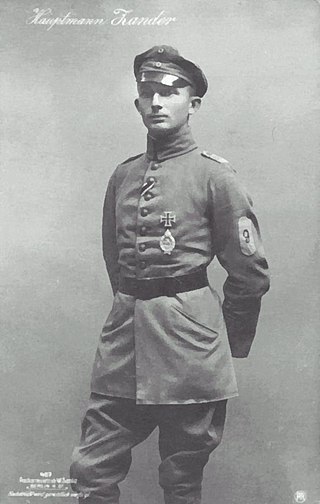Related Research Articles

Hauptmann Wilhelm "Willi" Reinhard was a German pilot during World War I. Reinhard became a flying ace during the war, credited with 20 confirmed aerial victories. After commanding two successive fighter squadrons, he was picked to replace Manfred von Richthofen as commander of Jagdgeschwader 1 when the Red Baron fell in combat. Reinhard died on 3 July 1918 while testing a prototype fighter.

Adolf Ritter von Tutschek (16 May 1891 – 15 March 1918) PlM, MOMJ was a professional soldier turned aviator. As German air strategy turned towards concentrated air power, he was entrusted with one of the world's first fighter wings.

Eduard Florus Harald Auffarth Royal House Order of Hohenzollern, Iron Cross, Silver Wound Badge, Hanseatic Cross, was a World War I German fighter ace credited with 29 victories. After the war, he ran an aviation training school that covertly supported establishment of the Luftwaffe.
Generalmajor Otto Fruhner MMC, IC, was a German World War I flying ace credited with 27 victories. He was one of the first aviators to parachute from a stricken aircraft.
Leutnant Hermann Becker, was a World War I German flying ace credited with 23 victories.

HauptmannMartin Zander was a World War I flying ace credited with five aerial victories. He was appointed to command one of the original German fighter squadrons, Jagdstaffel 1, before becoming an instructor.
OberleutnantErich Hahn was a World War I flying ace credited with six aerial victories.
VizefeldwebelAlfred Hübner was a World War I flying ace credited with six aerial victories.
Major Hermann Gilly was a World War I flying ace credited with seven aerial victories. He came to aviation service after two years infantry combat service, which saw him promoted to Leutnant in March 1916 while in Russia. He would not begin his flying career until November 1916. He served as an artillery cooperation pilot in Italy from November 1917 to March 1918. He was reassigned to a fighter unit, Jagdstaffel 40, effective 14 April 1918. Gilly scored seven aerial victories from 24 May 1918 through war's end. He was discharged on 22 January 1919.

VizefeldwebelGustav Schneidewind was a World War I flying ace credited with seven aerial victories.
Leutnant Kurt Adolf Monnington (1891–1939) was a World War I flying ace credited with eight aerial victories.
VizefeldwebelMichael Hutterer MMC IC was a World War I flying ace credited with eight aerial victories.

Leutnant Hans Christian Friedrich Donhauser was a German World War I flying ace credited with 19 aerial victories.
LeutnantRudolf Klimke IC was a German World War flying ace credited with 17 confirmed and two unconfirmed aerial victories. Serving initially as a bomber pilot, his aggressiveness in bombing England, and in shooting down a couple of enemy airplanes got him reassigned to a fighter squadron. After a string of a dozen victories during 1918, he was wounded in action on 21 September 1918.
LeutnantKarl Odebrett was a German World War I flying ace credited with 16 aerial victories.
Vizefeldwebel Karl Bohnenkamp was a World War I flying ace credited with 15 aerial victories. He scored his first victory on 21 September 1917 and continued through 28 October 1918. His 15 victories made him the leading ace in his squadron. He was awarded the Military Merit Cross on the latter date.

Willy Rosenstein, Iron Cross, was a German flying ace in World War I, credited with 9 victories.
Leutnant Heinrich Arntzen was a German World War I flying ace credited with eleven aerial victories.

Oskar Hennrich was a German World War I flying ace credited with 20 aerial victories. He was a notable balloon buster, as thirteen of his wins were destructions of observation balloons. He was the leading ace of his squadron, and ended his service with the rank of Vizefeldwebel.
LeutnantHermann Habich (1895–?) was one of the original pilots in the Imperial German Air Service, having earned his brevet two months before World War I began. He is noted for having killed French aviation pioneer Roland Garros. Habich scored seven victories in all, becoming a flying ace. He joined the Luftwaffe in the 1930s and served in World War II.
References
- Franks, Norman; Bailey, Frank W.; Guest, Russell. Above the Lines: The Aces and Fighter Units of the German Air Service, Naval Air Service and Flanders Marine Corps, 1914–1918. Grub Street, 1993. ISBN 0-948817-73-9, ISBN 978-0-948817-73-1.